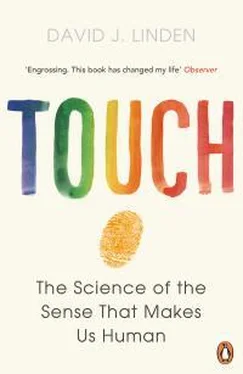29. V. E. Abraira and D. D. Ginty, “The sensory neurons of touch,” Neuron 79 (2013): 618–39.
30. For comparison, average sighted reading speed in English is about 250 words per minute. In both sighted and Braille reading there is a trade-off between speed and accurate comprehension.
31. J. R. Phillips, R. S. Johansson, and K. O. Johnson, “Representation of braille characters in human nerve fibers,” Experimental Brain Research 81 (1990): 589–92; F. Vega-Bermudez, K. O. Johnson, and S. S. Hsiao, “Human tactile pattern recognition: active versus passive touch, velocity effects, and patterns of confusion,” Journal of Neurophysiology 65 (1991): 531–46.
32. I know, I know—it’s kinda kinky. But we all must sacrifice for the truth. And because I know that you’re wondering, I’ll make it clear: She did not try doing two-point threshold discrimination on her clitoris.
33. The two-point discrimination threshold was a standard neurological test for many years, but it tends to systematically underestimate tactile resolution. In most labs it has since been replaced by a task in which gratings bearing raised ridges are pressed into the skin with constant force. The distance between the ridges is systemically varied and the subject is asked whether the ridges are running horizontally or vertically. K. O. Johnson and J. R. Phillips, “Tactile spatial resolution I. Two-point discrimination, gap detection, grating resolution and letter recognition,” Journal of Neurophysiology 46 (1981): 1177–92; R. W. Van Boven and K. O. Johnson, “The limit of tactile spatial resolution in humans: grating orientation discrimination at the lips, tongue and finger,” Neurology 44 (1994): 2361–66.
34. In the case of the neck and the head, the dorsal root ganglia are replaced by similar structures called the trigeminal ganglia. The technical term for neurons that have this shape is “pseudo-unipolar neurons.”
35. This assumes that the mechanosensory axons from our giant conduct signals at the same speed as those of conventional people.
36. For you hard-core anatomy mavens: Neurons that carry information from the mechanoreceptors have axons that ascend in the region of the spinal cord called lamina IV of the dorsal horn. Mechanoreceptor axons from the lower body, below the seventh thoracic vertebra, contact neurons in the gracile nucleus of the brain stem, while those of the upper body form synapses on neurons in the adjacent cuneate nucleus. The gracile and cuneate neurons send their axons to a particular subdivision of the thalamus called the ventroposterolateral region through a midline-crossing pathway called the medial lemniscus. These thalamic cells then project to the primary somatosensory cortex. In later chapters, we’ll discuss skin sensors for erotic touch, pain, itch, and temperature, which take a different path in both the spinal cord and the brain.
Also, a note on terminology: A bundle of axons is called a nerve when it’s running through the body (also called the periphery), but once it has entered the spinal cord or the brain, it’s called a tract.
37. Crossing of fibers in sensory and motor systems is widespread in the nervous system. In some cases, like the visual system, it makes sense: Your right visual field will activate the left side of the retina on both of your eyes. Therefore, in order to bring information from the right and left halves of the visual field together in the visual cortex, fibers from parts of the retina near the midline must cross in the brain. In the touch system, the reason for crossing is less clear and is sometimes a topic of argument when neuroscientists drink beer.
38. In Penfield’s day there weren’t effective antiepileptic drugs and these surgeries were performed only when the seizures were so severe that they were completely life-disruptive and dangerous. Penfield’s original description of brain mapping is still useful today: W. Penfield and T. C. Erickson, Epilepsy and Cerebral Localization: A Study of the Mechanism, Treatment and Prevention of Epileptic Seizures (Springfield, IL: Charles C. Thomas, 1941). For a clear and evocative description of Penfield’s surgeries as well as a broader meditation on the function of sensory and motor maps in the brain, see: S. Blakeslee and M. Blakeslee, The Body Has a Mind of Its Own (New York: Random House, 2008).
39. More recently, the primary somatosensory touch map has been explored with brain-scanning machines that can detect local brain activity in response to touch. It has also been revealed in laboratory animals by recording the electrical activity of individual neurons in the somatosensory cortex and then determining the location on the skin surface (on the opposite side of the body) where a touch will activate them. It turns out that maps are a ubiquitous feature of sensory systems in the brain and, like the touch map, are often distorted. The primary visual cortex has a map of the visual world (that’s upside down and backward) in which the center of the retina, which is most densely packed with light-detecting cells, is magnified. The auditory cortex has a map of pitch. Maps for the chemical senses, like smell, have been harder to understand, as odor-space is not as easily grasped as skin-space or retina-space.
40. Fans of the horror writer H. P. Lovecraft have been known to compare star-nosed moles to Lovecraft’s extraterrestrial creature Cthulhu, first described in a 1928 story: “A monster of vaguely anthropoid outline, but with an octopus-like head whose face was a mass of feelers, a scaly, rubbery-looking body, prodigious claws on hind and fore feet, and long, narrow wings behind.” Okay, so the mole doesn’t have wings, but still.
41. The world leader in studying the star-nosed mole is Kenneth Catania of Vanderbilt University. He has used high-speed video to show that when foraging, star-nosed moles search with their rays in a random fashion. But once a ray detects a potential food source, the star twitches so that a specialized supersensitive ray, number 11, now contacts the object. One or more touches with ray number 11 are typically required to determine whether the object really is prey and therefore should be consumed. When Professor Catania carefully examined the star-nosed mole’s cortical touch map, he found that not only did the star occupy an outsize portion of the somatosensory cortex but that within the star, number 11 occupied the greatest space of any ray. A nice review of this work is K. C. Catania, “The sense of touch in the star-nosed mole: from mechanoreceptors to the brain,” Philosophical Transactions of the Royal Society of London, Series B 366 (2011): 3016–25.
42. Cool nerdly detail: If you look at the skin in the finger pad you’ll see that a single sensory axon carries information from an array of Merkel endings in the skin spread over 2 to 3 millimeters in diameter. However, if you make an electrical recording from this axon while probing the finger pad with a fine-pointed instrument, you’ll find that it tends to respond to stimulation in a smaller area, about 1 millimeter in diameter. This is called the receptive field of the axon. The disparity between the receptive field and the anatomical distribution of endings suggests that something interesting is going on. Perhaps the Merkels at the edge of the array signal only weakly or perhaps their signals are actively blocked as the branches of the axon converge coursing toward the spinal cord.
43. The discovery of columnar organization of the neocortex was pioneered by Vernon Mountcastle and his coworkers at the Johns Hopkins University School of Medicine. A nice summary of this work may be found here: V. B. Mountcastle, The Sensory Hand (Cambridge, MA: Harvard University Press, 2005), 260–300.
Читать дальше












